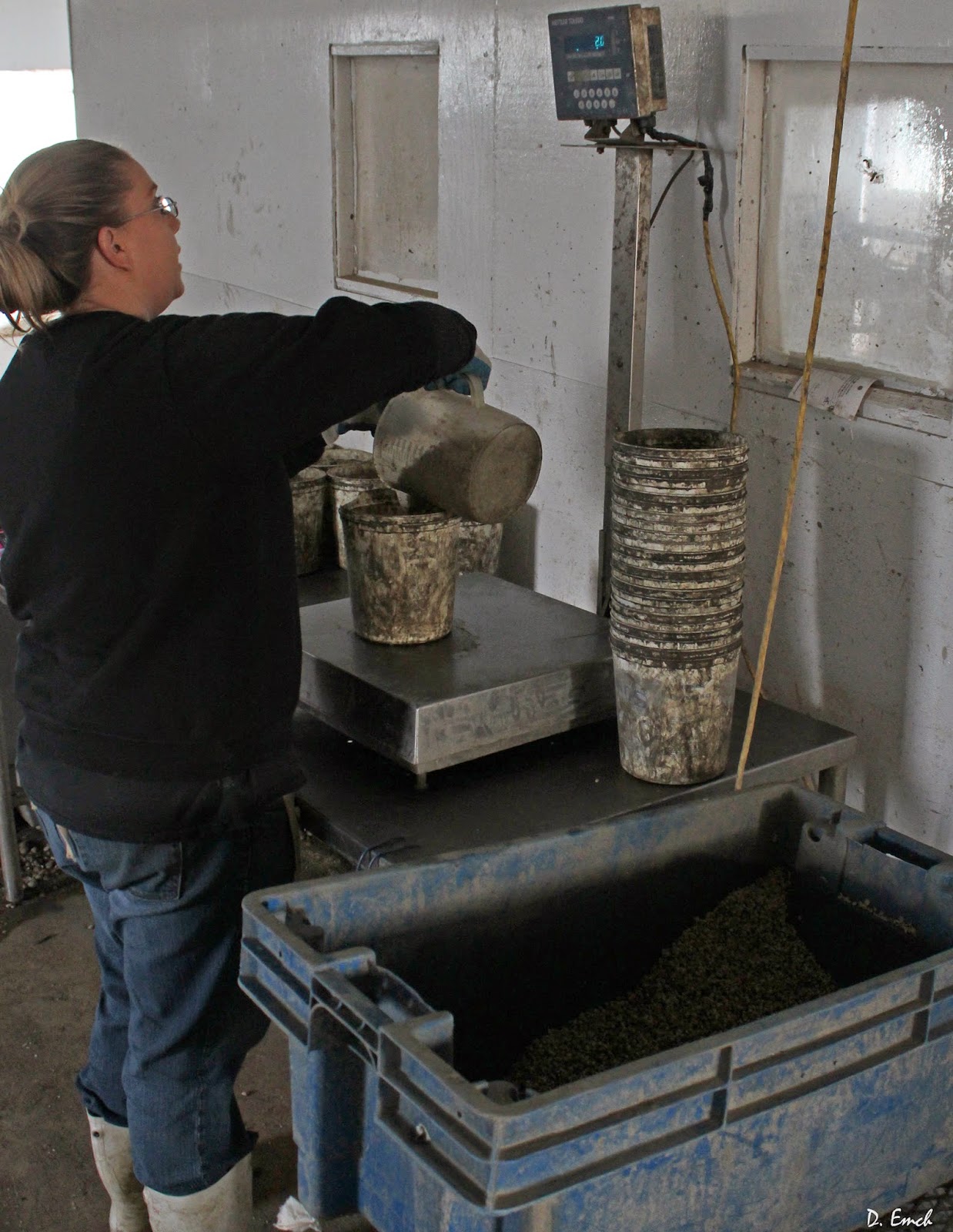Welcome to Townsend Georgia, a short stop on our way back to Darien. This is the home of Sapelo Sea Farms. This rural stretch of Georgia has virtually no industry, and this area in particular is surrounded by properties that have been set aside as nature preserves. The waters here are as clean as they come. And that is precisely Sapelo Sea Farms built one of the larges clam operations in the world here.
Meet Charlie Phillips, founder and owner of Sapelo Sea Farms and Phillips Seafood. Back in the late nineties, the State of Georgia approached Charlie about developing some clam beds on a 1000 acre piece of tidal flats here. Charlie complied, and has not looked back. He has built a business that employees a couple dozen people and delivers fifteen to twenty thousand pounds of clams a week to various markets, primarily United States and Canadian.
Clams grow to various sizes, depending upon their age. When Charlie gets them, they are about the size of a pencil eraser, as shown in a plastic tub below.
These "seeds" are then counted, with about a thousand seeds going into a mesh sack. The counting is actually done by weight.
Green plastic mesh is used to make bags
into which the juvenile clams are placed.
These are then loaded onto an air boat. This boat is used because it can navigate across the pluff mud flats even at low tide.
We headed out at dusk to the fields where the clams grow.
It is a picturesque ride out through the tidal marshes as the day's light slowly wanes.
We arrive at one section of the farm where workers have been loading mature clams onto another boat for several hours.
They have collected over 100 bags that average over forty pounds each. That is 2 tons of clams on their boat - it is sitting a bit low in the water.
They climb onto the airboat, and we head to another section where we are going to place these sacks of seed clams.
The bags are lain into long rows . .
and then they are unrolled so they lay flat.
These men work hard, but they seem to be in great spirits. It is a lot more beautiful place to work than sitting behind a desk . .
We ride back in as the sun sets. This is home to many forms of waterfowl and dolphin, many of whom put in an appearance.
A big heron looking to roost for the night passed through the reflection of the setting sun.
But these clams don't just get put out once and forgotten. After the seeds have matured six months, they are brought back in, separated and placed back into larger bags. They are then put back out to mature.
When the clams come off the boat, they are first put through this spinning cage so they can be washed.
Next they go through a machine that separates them by size. Different sizes are used for different things - the smallest Alfredo dishes and the largest are used in chowders.
They are then put in smaller mesh bags that are color coded for size and quantity. Each bag is immediately sealed with a label that lists the date and the weight so that freshness is assured down the line.
They are then boxed and placed on pallets . .
. . which are then placed into a large cooler. A refrigerated truck comes regularly for pickup and distribution to the various markets that have ordered them.
It is a clean, tight operation, and Charlie is very connected to the community and the land. He serves on the South Atlantic Fishery Management Council, which is responsible for maintaining the waters and animal species 200 miles out along the coast from North Carolina to Key West. Charlie talks extensively about best practices for caring for the natural resources. The coast can use more good stewards like him.
There are signs for other niche market businesses along the way. No one was at this place, but I am curious about the sturgeon roe business. Maybe we will see another place that handles it.
I love some of the places along route 99 on the way back to Darien. This one looks like it is straight out of one of those movies . .
I absolutely love this place.
Close inspection reveals the building was originally built with tabby, then reinforced with stone and brick. It also has had the long steel rods put in to hold the structure together. There were no markers giving the history of the place, but it certainly has some character.
Which brings us back to the Altamaha River. Just across the bridge in Darien is a large state waterfowl preserve.
Now, we have visited dozens of old rice plantations - but this place has the ruins of something we have not seen anywhere. This plantation had a steam powered rice mill. The ruins and an old house are all that is there - I would love to know how it operated.
There is another river on this preserve too - the Butler River. It is quite picturesque also.
Back on the plantation, many of the old rice fields are maintained and there are numerous canals and ponds full of all manner of wildlife. I didn't have time to walk the trails, but just drove where I was allowed. (I am slipping.) I liked this following scene also . .
And, as today's parting shot we have a sign prominently posted at the entrance to one of the marinas. I guess it speaks for itself . . .
EMAIL me if you
like, DONATE if you can,
Read
Today's Meditation if you have time, but whatever you do be sure to
. . .
Have an awesome Wednesday !!
David



































No comments:
Post a Comment